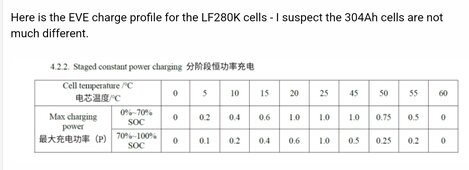再生可能 エネルギー
New Member
- Joined
- Nov 28, 2019
- Messages
- 261
Hi, just doing some brainstorming... I am in the design to build a 16 Cells 48V battery
and I am evaluating various layouts for putting together all the cells.
My first idea was to make a box with two rows of eight cells. So the box will be about 30" x 18" x 12".
But my concern is about the total weight, which will be about (16 x 12 lbs) = 192 lbs or 87 kg.
A second design would build two 24V batteries boxes, so the weight would be only 96 lbs or 44 kg each.
So each battery would be easy to carry and the 9" width would make it easy to put against a wall.
I am considering to install the batteries outside, so having two batteries would looks more like a powerwall,
and it would be easy to add a second 48V battery set in contiguity along the outside wall.
Questions:
In the case of making two boxes, would it be better to have two separate 24V BMS,
or to use one single 48V BMS in one box and having eight of the wires connected to the second box?
Also I am considering adding a second 48V battery in parallel, would it be better to have two 48V BMS or four 24V BMS?
Note: I would prefer having one single 48V BMS, but I wonder if at some point, when transporting the batteries,
would having eight of the cells of one box connected to the BMS and the other eight wires not connected could damage the BMS?
and I am evaluating various layouts for putting together all the cells.
My first idea was to make a box with two rows of eight cells. So the box will be about 30" x 18" x 12".
But my concern is about the total weight, which will be about (16 x 12 lbs) = 192 lbs or 87 kg.
A second design would build two 24V batteries boxes, so the weight would be only 96 lbs or 44 kg each.
So each battery would be easy to carry and the 9" width would make it easy to put against a wall.
I am considering to install the batteries outside, so having two batteries would looks more like a powerwall,
and it would be easy to add a second 48V battery set in contiguity along the outside wall.
Questions:
In the case of making two boxes, would it be better to have two separate 24V BMS,
or to use one single 48V BMS in one box and having eight of the wires connected to the second box?
Also I am considering adding a second 48V battery in parallel, would it be better to have two 48V BMS or four 24V BMS?
Note: I would prefer having one single 48V BMS, but I wonder if at some point, when transporting the batteries,
would having eight of the cells of one box connected to the BMS and the other eight wires not connected could damage the BMS?
Last edited:




